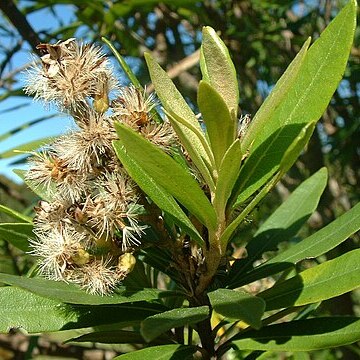Shrub or tree 1.5-9 m, evergreen, strongly branched; stem 2.5-5 cm in diam., with brown to dark grey smooth or fissured bark; branches sulcate, reddish with substellate trichomes when young, glabrescent. Leaves short-petiolate, narrowly elliptic to narrowly obovate, 3-11 x 0.8-2.3 cm, base attenuate, margins revolute, entire or very rarely with 1-2 teeth (serrate on coppice shoot leaves), apex obtuse or acute, adaxially glossy dark green and glabrous, abaxially dull pale green and glabrous or (when young) with sparse reddish scales or branched hairs; petiole 3-10 mm; secondary veins faint, 12-16, tertiary venation reticulate. Capitula in axillary or terminal panicles or less often racemes; corollas white, sweet-scented (always?). Male inflorescence 4-15 cm long, branched to 2 or 3 orders, but the larger ones with linear bracts which may be very young leaves; capitula 5-10 mm high, 7-14-flowered; stalks of individual capitula 1-3 mm long, puberulous or glabrous, with few bracts; involucre campanulate, 3-5 mm high, 2.5-4 mm in diam.; phyllaries 2-5-seriate, broadly ovate or elliptic, 1-4 x 1-3 mm, obtuse, with scarious margins, sparsely pubescent or glabrous, often glandular; receptacle flat or nearly so; corolla tube cylindric, slightly widening distally, 2.2-3 mm long, lobes 1.5-2.5 x 0.4-0.5 mm, somewhat glandular, rarely pilose as well, anthers 1.6-2.5 mm, tailed (to 0.3 mm), filaments eventually exserted, to 1 mm long, style 5-7.3 mm long, obtuse or subacute, undivided or bifid, the branches to 0.5 mm long and papillose; achenes cylindric, 1-1.6 mm, pubescent or pilose, glandular; pappus 1.5-4 mm long, the bristles few to rather many, 2-seriate, the inner slightly flattened. Female inflorescence 3-7 cm long, the terminal ones longer but with bracts developing into leaves; capitula 5-9 mm high, 6-11-flowered; stalks of individual capitula 1-3 mm, puberulous, with few bracts; involucre campanulate, 3.5-5 mm high; phyllaries 4-5-seriate, ovate to narrowly ovate, 1-4.5 x 0.8-2.5 mm, obtuse, rarely ciliate, sparsely pubescent, often glandular; corolla tube cylindric, wider at base, 2.2-3.5 mm long, sparsely glandular, lobes 1.1-1.6 mm long, sparsely glandular, staminodes present and thread-like, style 3.5-6 mm long, with ovate, subobtuse branches to 0.6 mm. Achenes slightly flattened or cylindric, 1.7-2.8 mm long, 3-5-angled pubescent (rarely glabrous), glandular, pappus of many bristles, 3-5 mm long, some slightly flattened at base.
More
Small tree or shrub, 2-8 m high. Leaves alternate, petiolate, oblanceolate to narrowly oblanceolate, margins entire or dentate in upper part, upper surface glabrous, lower surface glabrous or rusty brown tomentose. Capitula discoid, unisexual, many together in axillary or terminal panicles; involucral bracts imbricate. Florets male and female on different plants, whitish. Flowering time Mar.-Aug. Pappus of many barbellate bristles. Cypselae oblanceolate to narrowly elliptic, 3-5-angled, hairy.
Dioecious, leafy shrub or tree to 8 m, sparsely rusty velvety. Leaves aromatic, oblanceolate, sometimes slightly toothed, leathery, margins revolute, base decurrent into a short petiole. Flower heads discoid, in short racemes or panicles, whitish.

